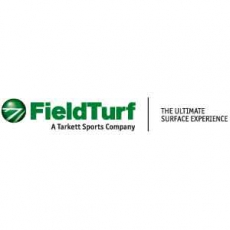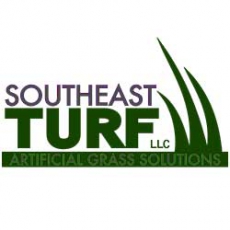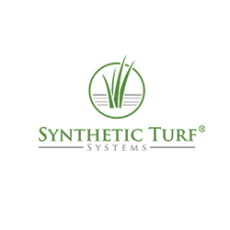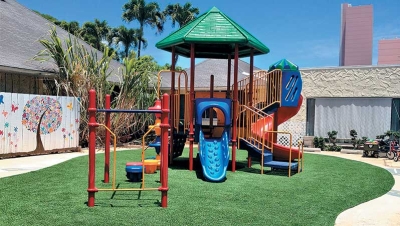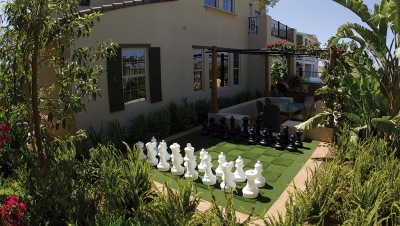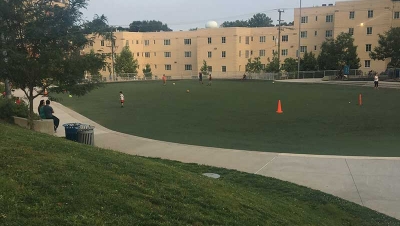FieldTurf started in the late ’80s, installing turf for tennis courts and golf tee boxes. The product evolved into its current form in the early ’90s and the initial break came in October of 1993 when, after presenting their product at numerous trade shows, FieldTurf was able to sell installations for indoor soccer facilities. Since then, the company has conducted extensive research and development to improve the quality and longevity of FieldTurf and its application in the world of football, soccer, baseball, golf, rugby, and lacrosse.
Just over a year ago, this Montreal-based company introduced its revolutionary new playground surface product comprised of monofilament fibers, offering unparalleled durability while remaining non-abrasive. Additionally, the system is wheelchair accessible and is custom-designed to accommodate all safety recommendations and fall heights required by any type of playground equipment.
Currently the largest entity in the sports surfacing industry, FieldTurf Tarkett provides unparalleled leasing capabilities, and engineering and manufacturing resources. In addition to its world-renowned FieldTurf and Prestige brands of artificial turf, it provides an equally impressive range of products including synthetic and hardwood basketball, volleyball, and gymnasium flooring, squash and racquetball courts, floor protection and covering systems, and weight room flooring. Also in the line of FieldTurf Tarkett products are indoor and outdoor running tracks including the high-performance ‘Le Monde’ track system, playground surfacing, and a complete range of tennis and golf surfaces.
What sets them apart?
FieldTurf is the only turf supplier that manufactures its own turf. Because of this in-house approach, FieldTurf‘s plants ensure a consistent high-quality product and uniform installations around the globe. Many turf companies use a variety of fiber manufacturers, and their clients seldom know for sure what fiber they will end up getting. Not so with FieldTurf. Its fields have been made with the same fiber—exclusive to FieldTurf—for over 10 years and no other fiber has passed this “test of time.” Whether clients purchase the FieldTurf Classic series with its proven slit film fiber or the new FieldTurf Monofilament series, the supply of such a critical component will never be modified.
Infill Mass
As compared to an average of three pounds of ambient rubber found in most other artificial turf products, each square foot of FieldTurf contains approximately seven pounds of silica sand plus three pounds of cryogenic rubber which is 560,000 lbs. more mass than the typical all-rubber infilled field.
Infill Sand & Rubber
FieldTurf uses only silica sand and cryogenically ground rubber particles. Silica sand does not break down with heavy use. Unlike ambiently ground rubber (the most plentiful and cheapest kind available), cryogenic rubber’s spherical particles are smooth-sided—they are shaped like silica sand and do not attract air or water bubbles. As a result, FieldTurf‘s cryogenic rubber and silica sand will not segregate, and the rubber will not tend to float or freeze like ambient rubber.
Layered Installation
FieldTurf uses a patented layering system, brushing specially sized layers of sand and rubber in a systematic order. A base layer of silica sand is followed by multiple mixed layers of silica sand and cryogenic rubber and then topped with a final layer of specially graded cryogenic rubber. This slow and detailed process provides FieldTurf’s grasslike playing characteristics.
Future Plans
FieldTurf Tarkett plans to continue building upon its strong sports field brand and re-launching its Greenscapes (Golf, Landscape, Playground, and Pets) division to better serve its clientele as well as continuing to provide its customers with the best products and the best customer service. “FieldTurf maintains the only fully functioning and self-sufficient team in the business,” explains Darren Gill, director of marketing. The head office at FieldTurf houses more than 100 highly skilled professionals, charged with designing, engineering, managing, and servicing each project. Its R&D team includes a staff of ten project managers and engineers who work together to design, engineer, and manage each job as an individual entity. “Our experts carefully ensure that the unique product meets the design specifications from beginning to end, gets to where it is supposed to on time and is installed exactly as it should be. Nothing is left to third parties and nothing is left to chance,” notes Gill.

